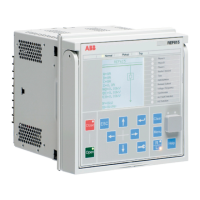7. Measurements
The relay continuously measures the phase cur-
rents, the symmetrical components of the currents
and the residual current. If the relay includes volt-
age measurements, it also measures the residual
voltage, the phase voltages and the voltage se-
quence components. Depending on the standard
configuration the relay additionally offers fre-
quency measurement. The relay also calculates the
demand value of the current over a user-selectable,
pre-set time frame, the thermal overload of the
protected object, and the phase unbalance based
on the ratio between the negative-sequence and
positive-sequence current.
Furthermore, the relay offers three-phase power
and energy measurement including power factor.
The measured values can be accessed via the local
HMI or remotely via the communication interface of
the relay. The values can also be accessed locally or
remotely using the Web HMI.
The relay is provided with a load profile recorder.
The load profile feature stores the historical load
data captured at a periodical time interval (demand
interval). The records are in COMTRADE format.
8. Power quality
In the EN standards, power quality is defined
through the characteristics of the supply voltage.
Transients, short-duration and long-duration volt-
age variations and unbalance and waveform distor-
tions are the key characteristics describing power
quality. The distortion monitoring functions are
used for monitoring the current total demand dis-
tortion and the voltage total harmonic distortion.
Power quality monitoring is an essential service
that utilities can provide for their industrial and key
customers. A monitoring system can provide infor-
mation about system disturbances and their possi-
ble causes. It can also detect problem conditions
throughout the system before they cause customer
complaints, equipment malfunctions and even
equipment damage or failure. Power quality prob-
lems are not limited to the utility side of the sys-
tem. In fact, the majority of power quality problems
are localized within customer facilities. Thus,
power quality monitoring is not only an effective
customer service strategy but also a way to protect
a utility's reputation for quality power and service.
The protection relay has the following power qual-
ity monitoring functions:
• Voltage variation
• Voltage unbalance
• Current harmonics
• Voltage harmonics
The voltage unbalance and voltage variation func-
tions are used for measuring short-duration volt-
age variations and monitoring voltage unbalance
conditions in power transmission and distribution
networks.
The voltage and current harmonics functions pro-
vide a method for monitoring the power quality by
means of the current waveform distortion and volt-
age waveform distortion. The functions provides a
short-term three-second average and a long-term
demand for total demand distortion TDD and total
harmonic distortion THD.
9. Fault location
The relay features an optional impedance-measur-
ing fault location function suitable for locating
short-circuits in radial distribution systems. Earth
faults can be located in effectively and low-resis-
tance earthed networks. Under circumstances
where the fault current magnitude is at least of the
same order of magnitude or higher than the load
current, earth faults can also be located in isolated
neutral distribution networks. The fault location
function identifies the type of the fault and then
calculates the distance to the fault point. An esti-
mate of the fault resistance value is also calculated.
The estimate provides information about the pos-
sible fault cause and the accuracy of the estimated
distance to the fault point.
10. Disturbance recorder
The relay is provided with a disturbance recorder
featuring up to 12 analog and 64 binary signal chan-
nels. The analog channels can be set to record ei-
ther the waveform or the trend of the currents and
voltages measured.
The analog channels can be set to trigger the re-
cording function when the measured value falls be-
low or exceeds the set values. The binary signal
channels can be set to start a recording either on
the rising or the falling edge of the binary signal or
on both.
By default, the binary channels are set to record ex-
ternal or internal relay signals, for example, the
start or trip signals of the relay stages, or external
blocking or control signals. Binary relay signals,
such as protection start and trip signals, or an ex-
ternal relay control signal via a binary input, can be
set to trigger the recording. Recorded information
is stored in a non-volatile memory and can be up-
loaded for subsequent fault analysis.
26 REF615 ANSI 5.0 FP1 FEEDER PROTECTION AND CONTROL

